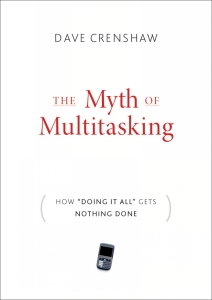About 20 years ago, I read my first "management fable" style of book. It was the classic Ken Blanchard book, "The One Minute Manager." I wasn't 'wowed' by the book, but I really liked the fable-style presentation. Since then, I've really enjoyed the fable style of business books, and quite a few management fables have made a lasting impression on me (you can see some of them in the "Related items" listing at the end of this review)."Remember this rule: the more responsibility you have, the more hats you wear, the more likely you are to become inefficient."
I'm happy to say that I've just read another book that's going to be a lasting part of my memory: it's Dave Crenshaw's, "The Myth of Multitasking (How 'Doing It All' Gets Nothing Done)".
You're fooling yourself
The core principle of this book really resonated with me: you're fooling yourself when you try to "multitask" activities that require your focus and attention, as this approach introduces inefficiencies that cost you more (both in terms of time and quality) than you realize.
Crenshaw presents a tale of Helen Whitman, a chaotic, frustrated business leader who is working very hard but getting burned out because her business's results are flatlining. Helen's frenetic work style has rubbed off on the rest of the business, creating lots of activity but yielding very little in terms of results.
The coach quickly determines that Helen's problem is her work style (which she thinks of as multitasking) is preventing her from giving adequate attention to important tasks, her family, and her team. The coach explains that multitasking is a myth -- a 'damned lie' to be precise -- and she isn't doing multiple things at once. What she is actually doing is rapidly shifting from one task to another. In the book, this approach is called "switchtasking," and there is a great exercise in the book to show the inefficiency of switchtasking.
What about the times when you feel you can successfully do two things at once? The coach makes a distinction between switchtasking and "background tasking" such as driving while talking on the phone, but he asserts that even with background tasking there is a cost.
Using some simple but illuminating exercises, the coach illustrates just how inefficient switchtasking really is and then takes Helen through a process to illustrate just how much this inefficiency is costing in terms of productivity. Through these activities, Helen realizes her sense of time is very distorted and she also becomes painfully aware that her efforts to give people and multiple tasks her attention all at once is creating some extreme dysfunction in her relationships with her family and employees.
Worse, Helen realizes that her bad habits are rubbing off on her team, and trickling down to impact their relationships with customers. Not good. But, as the saying goes, the first step is to admit you have a problem and ask for help -- and Helen does just that.
The rest of the book takes us through the changes (small and large) that Helen makes in her working style which help her defend her time, and strengthen others' trust in her by demonstrating that she is worthy of their trust.
Don't worry - you, too, can have a happy ending
OK, you're probably not surprised that the book has a happy ending, but you may be pleasantly surprised at some of the practical methods it includes to help you gain control of your time, improve your results and achieve a better quality of life.
To augment the story, Crenshaw includes a meaty set of worksheets and exercises in the appendix to help you replicate the same kind of personal discovery and analysis that Helen goes through in the book. It's up to you to apply what you learn, but I found it very helpful to have the tools at hand along with the instructions for how to use them.
This book is a quick and easy read -- the fable portion is about 100 pages long -- but it packs a lot of learning in a short space. I recommend it for anyone who wants to be more productive, but I particularly recommend it for anyone who believes they are a good multitasker. Is that you? If so - remember, it's not called "The Myth of Multitasking" for nothing...
Related items

